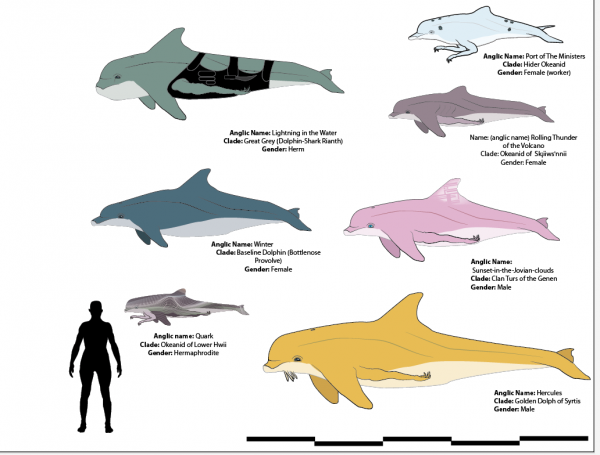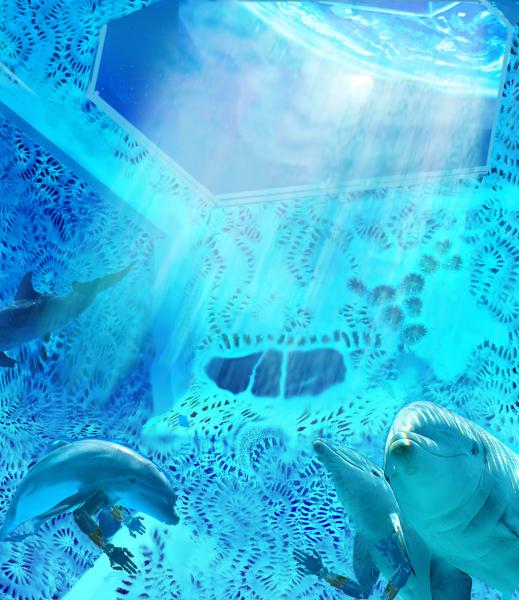BY LETTER
Enhanced Dolphins
Tursiops sapiens and many other species and minor variants
After chimpanzees, dolphins were the next significant step in the history of provolution. They proved to be a major challenge due to their extremely different ways of thinking, but historians of bioengineering agree that the eventual success was the sign that provolution science had left its infancy.
Several Enhanced Dolphin projects were initiated in 250 AT, most notably the GeneTEK Baja California project and the Cetacean Transition Consortium in the west Pacific. The main motivations were to get workers, explorers, and guards for the expanding underwater infrastructure (the same as inspired the Merpeople). The main problems were lack of manipulating limbs, human voicebox, not to mention the existence of a very alien cognitive space.
The limb issue was solved in two different ways; by adding cybernetic limbs (The CTC approach) or (more tricky) by genetically engineering two or four thin manipulator arms that could be folded into slits on the chest (the GeneTEK approach). In order to communicate with humans the blowhole was adjusted with a larynx, giving them understandable but squeaky human voices; among themselves they preferred to whistle. The melon was enhanced with a short-range acoustical lens enabling sonar observation at high resolution at close range.
As for the mental structure, the researchers attempted to tread lightly, just adding some primate-like operational and linguistic structures to the dolphin mind using implants and later genetic additions. It turned out that despite occasional hallucinations and a tendency to forget to use nouns the resulting minds worked quite well.
One problem in the initial provolve experiments was infanticide; like their wild ancestors dolphin males often instinctively killed the young of others. This was solved by hardwiring an intense paternal instinct into the Enhanced Dolphins. Enhanced Dolphins are for all practical purposes unable to harm or maltreat their young or small creatures like them, which has had the side effect that they enjoy pets (usually various fish species or pet humans) immensely. Some empathy genes was also included to make them bond better with humans and each other.
When the different projects began to bear success the competing groups either got out of the race or joined with the likely winners, sharing genomes and tricks. In the end, GeneTEK and the CTC unveiled their respective forms in the same year (295 AT). Having played the media and public opinion well the enhanced dolphins briefly became media darlings and there was even a new age revival claiming the "dolphin-humans" would be the harbingers of the true Aquarian Age.
Over the next century enhanced dolphins were put at work at undersea projects around the world as engineers, overseers, guards and scouts, leased from a number of Dolphin Temp agencies owned by GeneTEK and CTC. Over time the two dolphin lines were gradually combined into the ancestors of the modern enhanced dolphins, getting rid of the need for bionic implants. While some people treated the enhanced dolphins as more or less equal, to the agencies they were just useful biological robots. Just as with the merpeople this caused many conflicts, but since there were no strong laws against more radical coercion against sentient animals the agencies were free to employ track/stun collars, genetically engineered chemical dependency or kill implants to enforce their will.
Relations between merpeople and enhanced dolphins were complicated. Despite the media image of the two aquatic sentients living side by side in sugary new age harmony, there were many prejudices and conflicts between them. Part was due to the mistrust and competition of their originating corporations, but there were many other issues for friction such as the use of enhanced dolphins as underwater police, the enhanced dolphin tendency to regard the merpeople as failed experiments, the merpeople's view of the dolphins as little more than corporate slaves and many cases of technology theft. At the same time they shared a distrust of the surface powers and could communicate fairly directly. It is likely that renegade dolphins and merpeople worked together, although the details are little known.
Enhanced dolphins had a very good grasp of three-dimensional space, and soon found themselves in demand for space navigation tasks. In space some eventually became citizens of the Genetekker Republic where they excelled as pilots. They had little aversion against genetic modifications and cyborgisation, often going for more radical enhancements than most humans would deem advisable in order to "catch up on evolution".
During the dark ages, Enhanced Dolphins survived only in two places outside the Earth.
One place of survival was the few surviving GeneTEK orbitals, where corporate enhanced dolphins worked in some aquatic areas. During the dark ages they became tightly integrated with the tweaks, and during the First Federation they became part of the Genen. They do not regard themselves as dolphins anymore (and regard it as a horrible insult to be reminded of their "irrelevant" non-human origin), but primarily as clan Turs of the Genen. They have colonised several worlds across known space, although the largest population lives in the oceans of Frog's Head.
The other place was the Okeanos habitat, a mostly oceanic O'Neill habitat acting as a wilderness preserve housing cetaceans (either cloned from stored genetic samples or imported from the Earth). The owner's idea was to construct the habitat in the belt where water ice was fairly cheap, let the ecosystem settle and then move it insystem to act both as an environmental preserve and ecotourism target. The enhanced dolphins were the largest part of the biological crew, with only a handful of humans around for surface work. All other functions were handled by the local AI Okeanos and its vecs. As the Technocalypse struck, it acted quickly and used part of the ocean as reaction mass to launch the habitat into the outer system. Over the next centuries the inhabitants managed to survive, although the human contingent died out within 50 years. They developed a somewhat cetacean-centric worldview, regarding humans as tinkering monkeys that had just become lucky; they lacked the true dolphin intuition, they just saw the surface while the dolphins could see the interiors of things.
As the dark ages ended, the Okeanids spread in the new federation. Most were quickly assimilated within other cultures, but a noticeable fraction remained loyal to the spirit of the old Okeanos ideology and formed a loose social network ("the great flock") spread over the solar system, keeping in touch and helping each other out. Okeanos became a sacred place (with the AI and whales as caretakers/gods). As the Federation expanded, the Okeanids forged alliances with the Empaths and many other fractions, participating in the outwards expansion but without forgetting the fact they never clearly told the humans: that the humans were just tools for the dolphin cause. Humans were intelligent and independent, and of course controlled a vast amount more of real estate, technology and money, but due to the dolphin intuition the dolphin spirit could always influence and bend the others to act in its interest. This self-serving view (which was curiously similar to the emerging Genen clade ideology) helped the dolphins to stand the often unfair treatment they got from humans - "the humans might appear to have an upper hand, but that is just because they can't see the depths..."
In 1432 a.t. Hwii, the first pure dolphin colony world was founded on Zeta Tucanae II. The original settlers had destroyed themselves when the cometary bombardment they used to add water to the planet got out of control and peppered the surface, creating a world of interlinked shallow lakes and seas suitable (after some biome seeding) for dolphins. It has remained largely a Dolphin world, dominated by various governments based on traditional Okeanid interpretations. Politically it allied itself with the Sophic League, even if it is only a lukewarm member.
The glacial fourth world in the system, known as Snowwhite, was terraformed by the Tall Pine Bios megacorp, and settled by the Ghauetti clade of cold-adapted superiors. After some initial tensions the two sides eventually came to an agreement, and formed the Hwii-run "Zeta Tucanae Union".
In 2282 Smooth Undulation and Crashing Rock, a charismatic dyad from Okeanos itself rebelled against the conservatism of Okeanism and warned that the dolphins had lost their intuition ("It has become a vision, not the echo from the unheard thermocline!" in their immortal words) and had become tainted by human thinking. The solution was to extend the true dolphin nature, and that could only be done by purification and total re-evolution. The purists left for the Keter Dominion, to set up their own hidden civilisation developing a pure dolphin science, technology and culture. If this succeeded is unknown, but there are persistent rumors that there exists a major very advanced dolphin-derived empire somewhere in the Hydra direction. A popular myth is that one day human space will be invaded by cyborg dolphin gods.
Smooth Undulation and Crashing Rock were only the first of a number of visionaries that found the Consolidation Era Okeanism stifling. Another clade of enhanced dolphins, who became known as the Wanderers (although among themselves they were only called the True Dolphins, embarked on a long journey of space exploration, led by the great dolph sage (some say crazybeing) Strange Diver, who had a vision of mighty habitats of black nanomatter. After a long odyssey taking them in amat-powered ships across half the known galaxy (an epic adventure that was much later to be romanticised by the fantasist Peodro Biyh in hir symbolism-dense Dolph Odus trilogy) the tiny fleet (never more than three ships, popular conceptions notwithstanding) finally arrived at Gerkletoss Prime, at the time known as Rhion's System and inhabited by humans and the alien race known as the Ultimates. There they discovered that the Black Acropolis biospheres built by a lost alien race could indeed been easily be adapted for aquatic existence. Thus were the seeds laid for the multi-species Gerkletoss culture.
 Image from Juan Ochoa |
Today dolphin-derived species exist throughout known space, although most have claded to the extent that they no longer appear remotely similar to their ancestors. The most traditional are likely the relativist dolphins, many of which are part of the Vacuum Swimmers, a relativist shipping/colonisation/exploration network manned totally with dolphins and aquatic humanoids. The Okeanos habitat still remains, largely a museum/shrine to the dolphin family.
The most famous dolphin species of the current era are the golden dolphs of Syrtis, enhanced dolphin cyborgs with a fierce macho culture that played a heroic part (although historians disagree on how important it was) in the Dawn Mutual Protection Treaty Organisation's campaign against the Daveth tweaks 5100-5400; the myths they and others have created about their heroism have become an integral part of the culture of many heroic-individual oriented cultures. The fact that the Syrtis warriors have been largely inactive for more than 2000 years does not diminish their reputation.
Related Articles
- Branswerg (Gliese 868)
- Cetacea
- Click Train - Text by M. Alan Kazlev
Series of low-frequency clicks produced by some aquatic animals (especially cetaceans), merpeople, and bioborgs during echolocation. This train passes through a sound-focusing organ (usually a fat-filled organ in the head - e.g. the "melon" of the toothed whale). The train of clicks is focused into a beam that bounces off objects and reflects (echoes) back to the receiver. - Dolphins
- Handtech
- Hwii
- Orca
- Oro Mistral
- Skiiws'nnii, Sk¡iiws'nnii
- Syrtis
Appears in Topics
Development Notes
Text by Anders Sandberg
Initially published on 26 July 2000.
images by Arik added 2016
Initially published on 26 July 2000.
images by Arik added 2016









